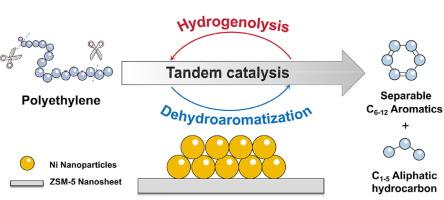Long-lived metal-zeolite catalysts for polyolefin aromatization via synergistic tandem dehydroaromatization and hydrogenolysis
IF 14.9
1区 化学
Q1 Energy
引用次数: 0
Abstract
Converting waste plastics directly into valuable aromatic chemicals is a promising, cost-effective recycling strategy. Traditional zeolite-catalyzed cracking of polyolefins to produce aromatics often needs high temperatures and faces issues like low selectivity for liquid aromatics, separation difficulties, and rapid catalyst deactivation due to coking. To address this, a multifunctional Ni/HZSM-5 catalyst was developed to efficiently upgrade various polyolefins—including polyvinyl chloride—into gaseous alkanes (C1–C5) and easily separable liquid aromatics (C6–C12) at 400 °C, without added solvents or hydrogen. Aromatic products make up 57.1 wt% of total output, with more than 97.8 % selectivity for the liquid phase and a BTX (benzene, toluene, and xylene) selectivity of 76.1 %. The high activity and selectivity for aromatics stem from synergistic interactions between Ni nanoparticles (NPs) and acid sites in the zeolite, which promote selective C–C bond breaking and control hydrogenolysis and aromatization pathways. This synergy allows precise control over the distribution of products by carbon number and favors the formation of separable aromatics. Notably, the catalyst also prevents coking by hydrogenolyzing and hydrogenating reactive intermediates before they form stable graphite-like deposits. Consequently, Ni/ZSM-5 catalyst demonstrates excellent stability, maintaining consistent aromatics yield over 13 consecutive cycles and processing over 30 times its weight in plastics without regeneration. After regeneration, the activity of the catalyst was fully restored, highlighting its potential for industrial use. This work offers valuable insights for designing durable, high-activity catalysts, providing a practical route to improve plastic recycling technologies.

长寿命金属-沸石催化剂的协同串联脱氢芳构化和氢解芳构化
将废塑料直接转化为有价值的芳香化学品是一种有前途的、具有成本效益的回收策略。传统的沸石催化聚烯烃裂解生产芳烃通常需要较高的温度,并且面临着液体芳烃选择性低、分离困难以及由于焦化导致催化剂快速失活等问题。为了解决这个问题,开发了一种多功能Ni/HZSM-5催化剂,在400°C下,不添加溶剂或氢,有效地将各种聚烯烃(包括聚氯乙烯)转化为气态烷烃(C1-C5)和易于分离的液态芳烃(C6-C12)。芳香产物占总产量的57.1%,液相选择性超过97.8%,BTX(苯、甲苯和二甲苯)选择性为76.1%。对芳烃的高活性和选择性源于Ni纳米颗粒与沸石中的酸位点之间的协同作用,促进了C-C键的选择性断裂,并控制了氢解和芳构化途径。这种协同作用允许通过碳数精确控制产品的分布,并有利于形成可分离的芳烃。值得注意的是,该催化剂还可以在反应性中间体形成稳定的石墨样沉积物之前通过氢化和加氢来防止焦化。因此,Ni/ZSM-5催化剂表现出优异的稳定性,在连续13个循环中保持一致的芳烃产量,并且在塑料中处理超过其重量30倍而不再生。再生后,催化剂的活性完全恢复,突出了其工业应用潜力。这项工作为设计耐用、高活性的催化剂提供了有价值的见解,为改进塑料回收技术提供了一条实用的途径。
本文章由计算机程序翻译,如有差异,请以英文原文为准。
求助全文
约1分钟内获得全文
求助全文
来源期刊

Journal of Energy Chemistry
CHEMISTRY, APPLIED-CHEMISTRY, PHYSICAL
CiteScore
19.10
自引率
8.40%
发文量
3631
审稿时长
15 days
期刊介绍:
The Journal of Energy Chemistry, the official publication of Science Press and the Dalian Institute of Chemical Physics, Chinese Academy of Sciences, serves as a platform for reporting creative research and innovative applications in energy chemistry. It mainly reports on creative researches and innovative applications of chemical conversions of fossil energy, carbon dioxide, electrochemical energy and hydrogen energy, as well as the conversions of biomass and solar energy related with chemical issues to promote academic exchanges in the field of energy chemistry and to accelerate the exploration, research and development of energy science and technologies.
This journal focuses on original research papers covering various topics within energy chemistry worldwide, including:
Optimized utilization of fossil energy
Hydrogen energy
Conversion and storage of electrochemical energy
Capture, storage, and chemical conversion of carbon dioxide
Materials and nanotechnologies for energy conversion and storage
Chemistry in biomass conversion
Chemistry in the utilization of solar energy
 求助内容:
求助内容: 应助结果提醒方式:
应助结果提醒方式:


